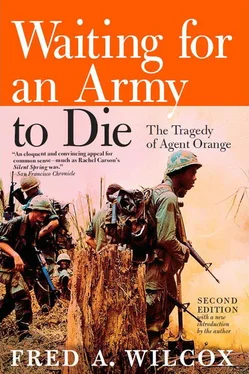On May 30, 1979, Max Cleland, director of the VA at the time, responded by rejecting all of the center’s suggestions. His argument against establishing an outreach program was curious. Although he knew that veterans were anxious and confused about contradictory reports on the toxicity of herbicides, Cleland felt that an outreach program would only cause veterans “needless anxiety.” According to the VA, men who had survived ambushes in the A Shau Valley, fought door to door in Hué, and humped through swamps in the Mekong Delta simply could not handle the anxiety of an outreach program.
Cleland also instructed the VA to deny all claims for service-connected disability due to Agent Orange exposure, arguing that it might take “another decade” for scientists to make a rational judgment on whether dioxin adversely affected human health. Cleland’s statements that the VA knew little or nothing about the health effects of dioxin, however, appear to be contradicted by a memo circulated to all 172 VA hospitals and fifty-eight regional offices on May 18, 1978. According to this memo, the VA felt it knew a great deal about the effects of dioxin on human beings. For example, the VA knew that herbicides used in Vietnam “have a low level of toxicity, both individually and when mixed. Furthermore they appear to be rapidly absorbed and completely excreted in both human and animal. Humans exposed repeatedly… may experience temporary and fully reversible neurological symptoms; however, the only chronic condition definitely [emphasis added] associated with such exposure is chloracne.”
Advising VA health personnel to approach Agent Orange complaints with extreme caution, the memo explains: “If the veteran has no objective symptoms or signs, simple reassurance should be offered. The veteran should be told that a record of the medical examination will be kept for future reference, but that if the veteran does not now have symptoms and did not previously experience any, the likelihood of herbicide poisoning is virtually zero.” It does not explain why veterans would visit VA outpatient clinics to complain about symptoms they either did not have or had not “previously experienced.” [10] For a copy of this memo, see Appendix, 191–194.
But it does warn VA staff not to make any entries in a patient’s file that might indicate a relationship between an illness and defoliant exposure “unless unequivocal confirmation of such a connection has been established.”
While publicly stating that it could not make a decision in favor of the veterans’ claims for disability, the VA had obviously come to the private conclusion that laboratory research showing dioxin to be carcinogenic, teratogenic, and fetotoxic could be dismissed by a bureaucratic edict. This particular memo is also important because it formulated just one of the many Catch-22s that would frustrate the efforts of veterans to secure disability payments. An entry into the patient’s file could not be made without “unequivocal confirmation” that the veteran’s illness was related to herbicide exposure. But according to a General Accounting Office report, “VA regional offices have been instructed to send copies of completed ratings of herbicide-related claims to headquarters for review. In addition, regional offices have been instructed to request information from a veteran’s service record to verify herbicide exposure. However, service records normally do not contain specific information on chemical exposure. As a result, responses to such questions are neither verified nor denied by military service record personnel.” 4
In order to substantiate their claims for disability, veterans were asked by the VA to produce information that did not exist. [11] In 1980 the VA rescinded the requirement that veterans prove exposure when asking for information, assistance, or treatment for what they believed to be Agent Orange-related illnesses.
It is difficult to imagine that the VA was unaware that the Department of Defense, whose records would presumably “verify” the veterans’ exposure to herbicides, had already stated that: “(1) no such personnel records were maintained, (2) it would be difficult to estimate meaningful exposure data because the potential for exposure varied widely among personnel, and (3) only a few military personnel would have been exposed directly to spraying.” 5
While VA health personnel were informed that the human body could “rapidly absorb” and “completely excrete” the herbicides, Max Cleland encouraged veterans to visit outpatient clinics for a “clinical evaluation.” These evaluations, said Cleland, would provide that basis for discovering any “unusual” health problems among Vietnam veterans. What Cleland did not say, of course, was that no matter how “unusual,” the illnesses would be treated by VA health personnel as having little or nothing to do with the massive defoliation of South Vietnam.
In his attempts to justify the VA’s policy on Agent Orange, Cleland often referred to his agency’s “Agent Orange Program Guide,” a seven-paragraph, one-page “no health effects” document that set down the official line for denying all disability claims. The “guide’s” brevity, however, was not the only reason why veterans and their supporters rejected it as a scam sheet and hype. Demonstrating once again its predilection for cloak-and-dagger politics, the VA had drafted the document “in secret and without the participation of other government officials knowledgeable about the scientific evidence.” 6
Before long the VA faced yet another lawsuit, this time on behalf of veterans who might have been, or would be, affected by the program guide—perhaps several hundred thousand. The VA then astonished the legal observers by declaring that veterans had “no standing” to “challenge the agency’s refusal to conduct rulemaking.” 7Lawyers representing the veterans noted that the VA made “the rather incredible argument that Vietnam veterans have not been sufficiently injured by the rule to challenge the fact that public rulemaking was not conducted before the rule was adopted and used… The agency takes the extraordinary position that it has the discretion, unlike any other federal agency, to decide whether it would comply with its own regulations at 38 C.F.R.S1.12 which require the agency to conduct rulemaking… Confronting this lawless position compels the obvious remark that such a view leads to a government of men, not law.” 8
To a nation that has accepted, albeit with anger and frustration, the idea that bureaucracies are cumbersome and unreliable, the VA’s resolute stalling might not seem so extraordinary. Moreover, if one accepts the idea that bureaucracies are inherently incompetent, the fact that the VA took “only” twelve months to open its meeting to the public might be interpreted as a kind of miracle. But with its response to the Environmental Protection Agency’s ban on domestic use of 2,4,5-T, the VA demonstrated that even top-heavy bureaucracies can move swiftly when they wish to. Taking only seven days to review the EPA’s decade of research, the VA announced that the studies on which the EPA’s ban was based did not “offer definitive evidence for an adverse effect of herbicides on human health.” But when asked through a Freedom of Information Act request to provide scientific evidence supporting the VA critique, officials said that no documents were available.
During the year following the EPA’s order, neither the VA’s Agent Orange Steering Committee nor its Agent Orange Advisory Committee discussed the matter further. When the VA held two “educational conferences” on Agent Orange for its hospital staff, representatives from the EPA were not invited. Requested by Congressman David E. Bonior (D-Mich.) and Thomas A. Daschle (D-S.D.) to consider the importance of five newly discovered human epidemiology studies on workers and others exposed to dioxin, studies the EPA had spent a great deal of time and money to evaluate, the VA again responded with astonishing speed that the studies were not persuasive enough to encourage the VA to any further action.
Читать дальше











